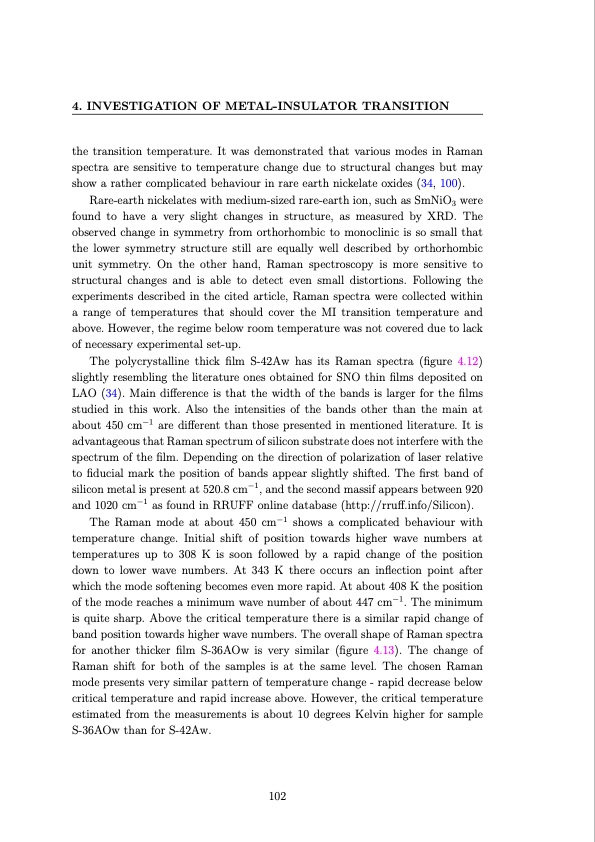
PDF Publication Title:
Text from PDF Page: 123
4. INVESTIGATION OF METAL-INSULATOR TRANSITION the transition temperature. It was demonstrated that various modes in Raman spectra are sensitive to temperature change due to structural changes but may show a rather complicated behaviour in rare earth nickelate oxides (34, 100). Rare-earth nickelates with medium-sized rare-earth ion, such as SmNiO3 were found to have a very slight changes in structure, as measured by XRD. The observed change in symmetry from orthorhombic to monoclinic is so small that the lower symmetry structure still are equally well described by orthorhombic unit symmetry. On the other hand, Raman spectroscopy is more sensitive to structural changes and is able to detect even small distortions. Following the experiments described in the cited article, Raman spectra were collected within a range of temperatures that should cover the MI transition temperature and above. However, the regime below room temperature was not covered due to lack of necessary experimental set-up. The polycrystalline thick film S-42Aw has its Raman spectra (figure 4.12) slightly resembling the literature ones obtained for SNO thin films deposited on LAO (34). Main difference is that the width of the bands is larger for the films studied in this work. Also the intensities of the bands other than the main at about 450 cm−1 are different than those presented in mentioned literature. It is advantageous that Raman spectrum of silicon substrate does not interfere with the spectrum of the film. Depending on the direction of polarization of laser relative to fiducial mark the position of bands appear slightly shifted. The first band of silicon metal is present at 520.8 cm−1, and the second massif appears between 920 and 1020 cm−1 as found in RRUFF online database (http://rruff.info/Silicon). The Raman mode at about 450 cm−1 shows a complicated behaviour with temperature change. Initial shift of position towards higher wave numbers at temperatures up to 308 K is soon followed by a rapid change of the position down to lower wave numbers. At 343 K there occurs an inflection point after which the mode softening becomes even more rapid. At about 408 K the position of the mode reaches a minimum wave number of about 447 cm−1. The minimum is quite sharp. Above the critical temperature there is a similar rapid change of band position towards higher wave numbers. The overall shape of Raman spectra for another thicker film S-36AOw is very similar (figure 4.13). The change of Raman shift for both of the samples is at the same level. The chosen Raman mode presents very similar pattern of temperature change - rapid decrease below critical temperature and rapid increase above. However, the critical temperature estimated from the measurements is about 10 degrees Kelvin higher for sample S-36AOw than for S-42Aw. 102PDF Image | Investigation of metal-insulator transition in magnetron sputtered samarium nickelate thin films

PDF Search Title:
Investigation of metal-insulator transition in magnetron sputtered samarium nickelate thin filmsOriginal File Name Searched:
Bilewska_Investigation_of_metal_insulator_transition_in_magnetron_sputtered_samarium.pdfDIY PDF Search: Google It | Yahoo | Bing
Sulfur Deposition on Carbon Nanofibers using Supercritical CO2 Sulfur Deposition on Carbon Nanofibers using Supercritical CO2. Gamma sulfur also known as mother of pearl sulfur and nacreous sulfur... More Info
CO2 Organic Rankine Cycle Experimenter Platform The supercritical CO2 phase change system is both a heat pump and organic rankine cycle which can be used for those purposes and as a supercritical extractor for advanced subcritical and supercritical extraction technology. Uses include producing nanoparticles, precious metal CO2 extraction, lithium battery recycling, and other applications... More Info
| CONTACT TEL: 608-238-6001 Email: greg@infinityturbine.com | RSS | AMP |